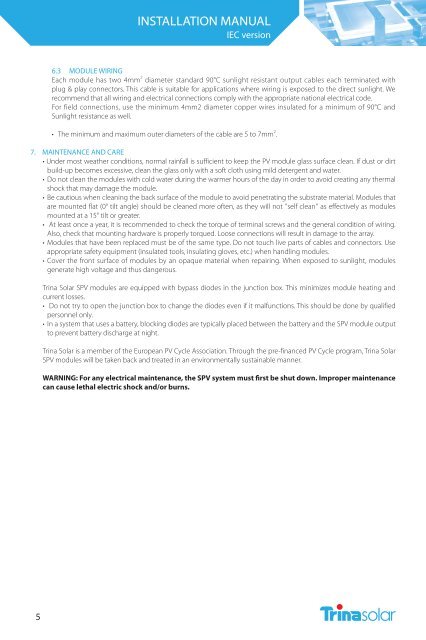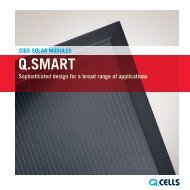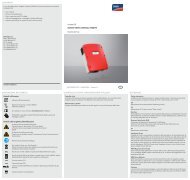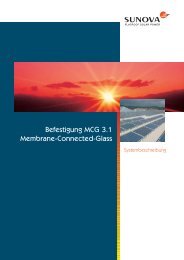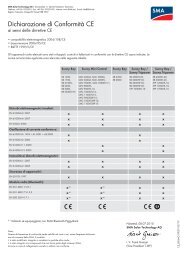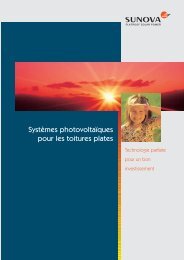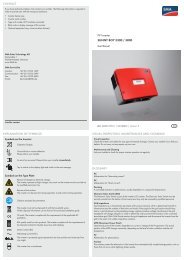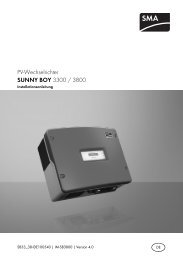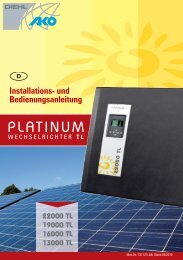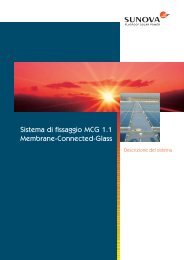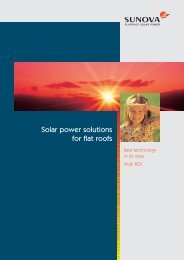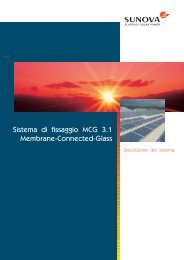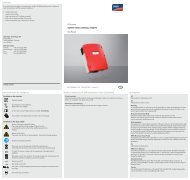Installation instructions - Sunova
Installation instructions - Sunova
Installation instructions - Sunova
Create successful ePaper yourself
Turn your PDF publications into a flip-book with our unique Google optimized e-Paper software.
INSTALLATION MANUAL<br />
IEC version<br />
6.3 MODULE WIRING<br />
Each module has two 4mm 2 diameter standard 90°C sunlight resistant output cables each terminated with<br />
plug & play connectors. This cable is suitable for applications where wiring is exposed to the direct sunlight. We<br />
recommend that all wiring and electrical connections comply with the appropriate national electrical code.<br />
For field connections, use the minimum 4mm2 diameter copper wires insulated for a minimum of 90°C and<br />
Sunlight resistance as well.<br />
• The minimum and maximum outer diameters of the cable are 5 to 7mm 2 .<br />
7. MAINTENANCE AND CARE<br />
• Under most weather conditions, normal rainfall is sufficient to keep the PV module glass surface clean. If dust or dirt<br />
build-up becomes excessive, clean the glass only with a soft cloth using mild detergent and water.<br />
• Do not clean the modules with cold water during the warmer hours of the day in order to avoid creating any thermal<br />
shock that may damage the module.<br />
• Be cautious when cleaning the back surface of the module to avoid penetrating the substrate material. Modules that<br />
are mounted flat (0° tilt angle) should be cleaned more often, as they will not ''self clean'' as effectively as modules<br />
mounted at a 15° tilt or greater.<br />
• At least once a year, it is recommended to check the torque of terminal screws and the general condition of wiring.<br />
Also, check that mounting hardware is properly torqued. Loose connections will result in damage to the array.<br />
• Modules that have been replaced must be of the same type. Do not touch live parts of cables and connectors. Use<br />
appropriate safety equipment (insulated tools, insulating gloves, etc.) when handling modules.<br />
• Cover the front surface of modules by an opaque material when repairing. When exposed to sunlight, modules<br />
generate high voltage and thus dangerous.<br />
Trina Solar SPV modules are equipped with bypass diodes in the junction box. This minimizes module heating and<br />
current losses.<br />
• Do not try to open the junction box to change the diodes even if it malfunctions. This should be done by qualified<br />
personnel only.<br />
• In a system that uses a battery, blocking diodes are typically placed between the battery and the SPV module output<br />
to prevent battery discharge at night.<br />
Trina Solar is a member of the European PV Cycle Association. Through the pre-financed PV Cycle program, Trina Solar<br />
SPV modules will be taken back and treated in an environmentally sustainable manner.<br />
WARNING: For any electrical maintenance, the SPV system must first be shut down. Improper maintenance<br />
can cause lethal electric shock and/or burns.<br />
5


